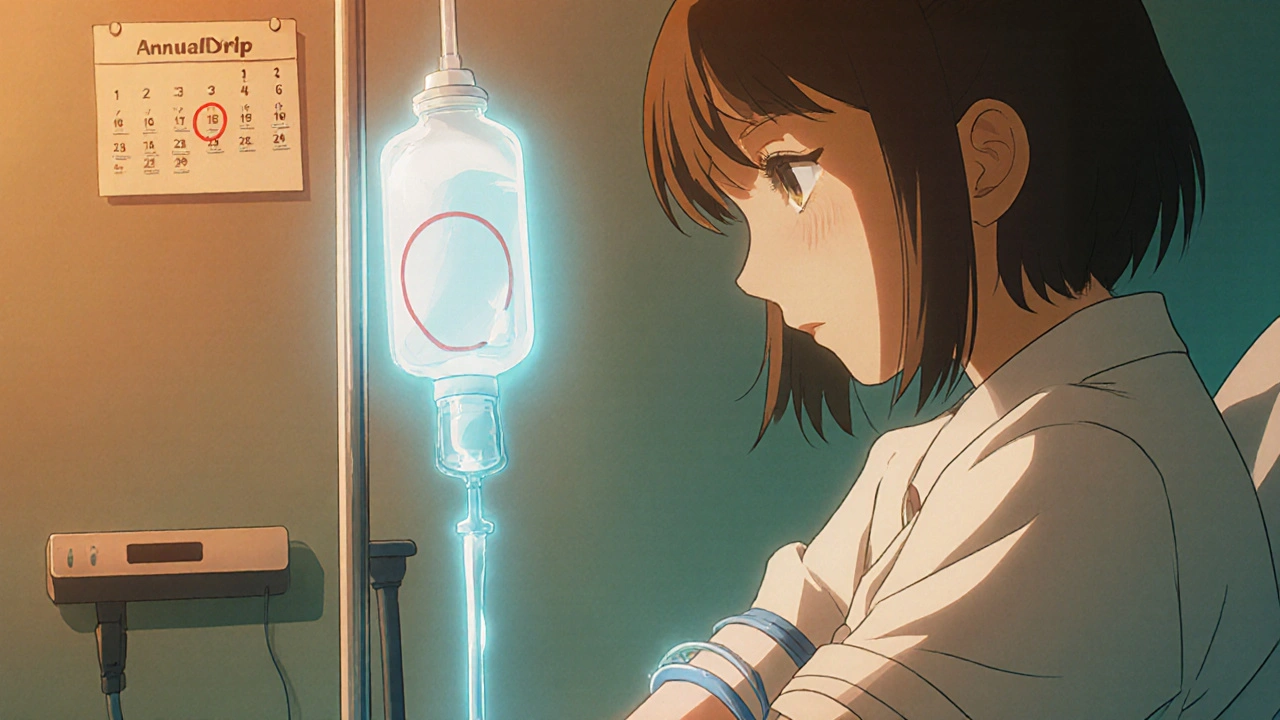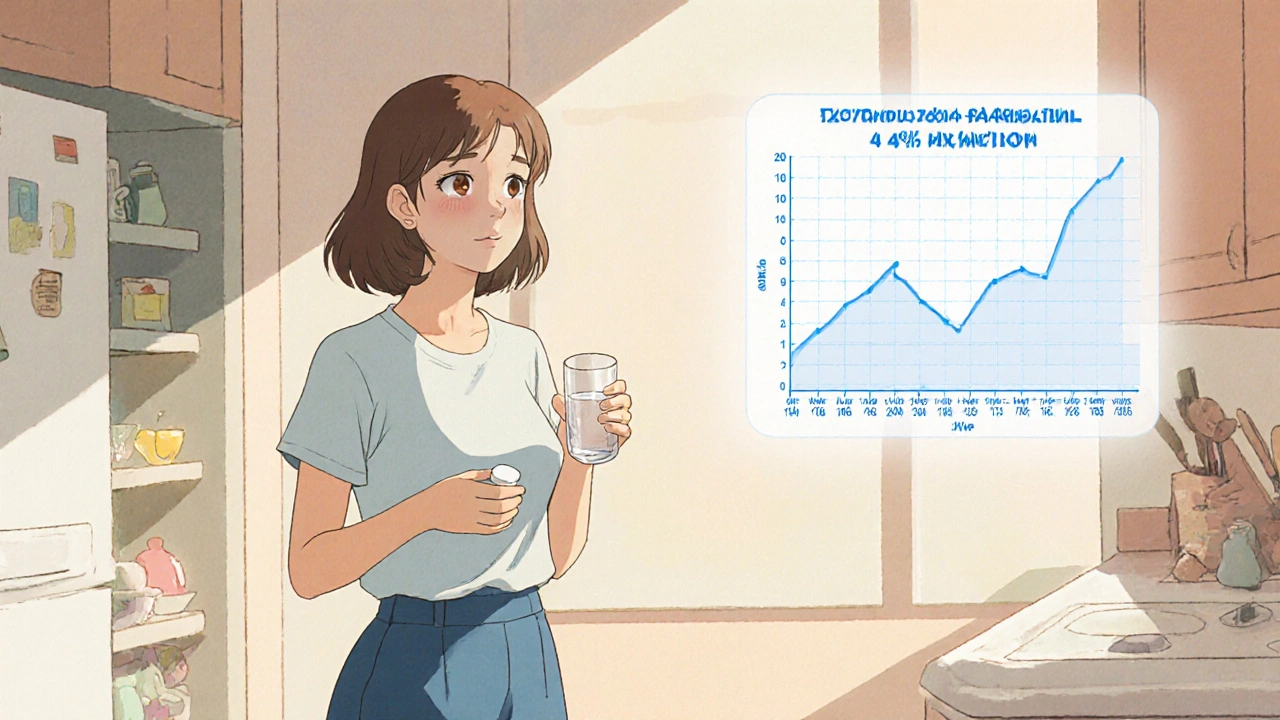Osteoporosis Treatment Matchmaker
Find Your Best Osteoporosis Treatment Match
Answer a few questions about your health and lifestyle to see which medication might work best for you.
Your Health Profile
Your Budget
Your Personalized Recommendations
Remember: This tool is for informational purposes only. Always discuss treatment options with your doctor.
If you’ve been prescribed Fosamax (alendronate) for osteoporosis, you’re not alone. Millions of people, especially postmenopausal women, take it every year to stop bone loss and reduce fracture risk. But it’s not the only option. Some people can’t tolerate the side effects. Others want something simpler, cheaper, or more effective. So what are the real alternatives-and how do they stack up?
What Fosamax (Alendronate) Actually Does
Fosamax is the brand name for alendronate, a bisphosphonate. It works by slowing down the cells that break down bone-osteoclasts. This lets bone-building cells (osteoblasts) catch up, so your bones get denser over time. Studies show it reduces spine fractures by up to 44% and hip fractures by about 25% over three years. That’s significant.
But here’s the catch: Fosamax has strict rules. You have to take it on an empty stomach with a full glass of plain water. Then you must stay upright for at least 30 minutes. No eating, drinking, or lying down. Skip those steps, and you risk serious irritation to your esophagus. Some people get heartburn. Others develop jawbone problems (osteonecrosis) or rare thigh bone fractures after years of use.
Boniva (Ibandronate): The Monthly Option
Boniva is another bisphosphonate, but it comes in a monthly pill or quarterly IV drip. That’s a big plus for people who forget daily pills. The oral version still needs the same upright waiting period as Fosamax, but the IV version? No swallowing, no fasting-just a 15-minute infusion every three months at your doctor’s office.
Studies show Boniva works just as well as Fosamax at increasing spine bone density. But it’s slightly less proven for hip fracture prevention. It’s also more expensive. If you struggle with daily pills or have acid reflux, Boniva’s IV option can be a game-changer. But if you hate doctor visits, the monthly pill might not feel like an upgrade.
Reclast (Zoledronic Acid): The One-and-Done
Reclast is the strongest player in this group. Given as a single annual IV infusion, it’s designed for people who want zero daily or weekly routines. One 15-minute drip per year. That’s it.
Research from the New England Journal of Medicine shows Reclast reduces spine fractures by 70% and hip fractures by 41% over three years-better than Fosamax in head-to-head trials. It also works faster. Bone density improvements show up in as little as six months.
The downside? The first infusion can cause flu-like symptoms: fever, muscle aches, fatigue. These usually fade within 48 hours. People with kidney problems can’t use it. And like all bisphosphonates, long-term use carries a small risk of jaw or thigh bone issues. But for many, the convenience outweighs the temporary discomfort.
Evenity (Romosozumab): The Bone Builder
Evenity is different. It’s not a bisphosphonate. It’s a monoclonal antibody that both builds new bone and slows breakdown. Think of it as a two-in-one tool. It’s not for everyone-it’s only approved for postmenopausal women at high risk of fracture, and only for up to 12 months.
One year of Evenity increases spine bone density by 13% and hip density by 5%. That’s more than double what Fosamax achieves in the same time. In trials, it cut spine fractures by 73% and non-spine fractures by 36%.
But here’s the catch: Evenity raises the risk of heart attack and stroke. The FDA added a black box warning. If you have a history of heart disease or stroke, you can’t use it. It’s also expensive-over $20,000 a year in the U.S., and not always covered by insurance. It’s powerful, but only for the right candidate.

Prolia (Denosumab): The Biologic Alternative
Prolia is another injectable, but it’s not a bisphosphonate. It’s a RANK ligand inhibitor. It blocks a signal that tells bone-breaking cells to activate. You get a shot under the skin every six months.
It’s just as good as Fosamax at increasing bone density and preventing fractures. In fact, some studies suggest it’s slightly better for hip fractures. The big advantage? No swallowing rules. No esophageal risk. No kidney restrictions.
But Prolia has its own risks. If you stop taking it, you can lose bone mass fast-sometimes within months. That’s why doctors often switch you to a bisphosphonate afterward. Also, there’s a small risk of serious skin infections and low calcium levels. You need to take calcium and vitamin D supplements while on it.
Calcium and Vitamin D: The Foundation
No matter which drug you choose, you need calcium and vitamin D. No exceptions. If you’re not getting at least 1,200 mg of calcium and 800-1,000 IU of vitamin D daily, even the best drug won’t work well.
Most people don’t get enough from food alone. A daily supplement is usually needed. But don’t just grab any pill. Look for calcium citrate if you have low stomach acid or take acid blockers. Calcium carbonate is cheaper but needs food to absorb. Vitamin D3 is the form your body uses best.
Some doctors test your vitamin D levels first. If you’re severely low, you might need a high-dose prescription for a few weeks before switching to daily maintenance. This isn’t optional. It’s the base layer.
Who Should Avoid Bisphosphonates?
Bisphosphonates like Fosamax aren’t safe for everyone. Avoid them if you:
- Have severe kidney disease (eGFR below 30)
- Can’t sit or stand upright for 30 minutes after taking the pill
- Have a history of esophageal problems (like Barrett’s esophagus or strictures)
- Have low calcium levels that haven’t been corrected
If any of these apply to you, skip Fosamax and talk to your doctor about Prolia, Reclast, or Evenity. They don’t rely on the same absorption pathway.

Cost and Insurance: What You’ll Actually Pay
Fosamax is generic alendronate. In the U.S., a 30-day supply costs as little as $10 with a coupon. Boniva and Reclast are more expensive-$150 to $500 per dose. Prolia runs about $1,200 every six months. Evenity is over $20,000 a year.
But insurance often covers these drugs differently. Medicare Part D usually covers bisphosphonates with low copays. Prolia and Reclast may need prior authorization. Evenity is rarely covered unless you’ve tried and failed other treatments.
Always check with your pharmacy. Some manufacturers offer patient assistance programs. For example, Merck’s Fosamax savings card can cut the cost to $10 a month. Don’t assume you can’t afford it-ask.
What Happens If You Stop?
Stopping osteoporosis meds without a plan can be dangerous. Bone loss can accelerate, especially after stopping Prolia or Evenity. That’s why doctors often recommend a "drug holiday"-a planned break after 3-5 years of bisphosphonates.
During a drug holiday, you’re monitored with bone density scans. If your bone density stays stable and your fracture risk stays low, you might stay off meds for 1-3 years. If it drops, you restart. This reduces long-term risks like jawbone damage.
Never stop cold turkey. Talk to your doctor first. Your plan should be personalized.
Final Decision: Which One’s Right for You?
Here’s a quick guide:
- Choose Fosamax if you want the cheapest, well-tested option and can follow the strict dosing rules.
- Choose Boniva if you hate daily pills and prefer monthly or IV dosing.
- Choose Reclast if you want maximum effectiveness with one yearly infusion and can handle temporary flu-like symptoms.
- Choose Prolia if you can’t swallow pills, have kidney issues, or want no esophageal risk.
- Choose Evenity only if you’re at very high fracture risk, have no heart disease, and need rapid bone building.
There’s no one-size-fits-all. Your age, fracture history, kidney function, budget, and lifestyle all matter. Work with your doctor to match the drug to your life-not the other way around.
Can I switch from Fosamax to another osteoporosis drug?
Yes, you can switch, but not without medical supervision. If you’re having side effects or your bone density isn’t improving, your doctor may switch you to Prolia, Reclast, or another option. Some patients go from Fosamax to Reclast for convenience. Others switch to Prolia if they can’t tolerate oral bisphosphonates. Never switch on your own-your bone health depends on the transition being managed properly.
Do any of these drugs cause weight gain?
None of the osteoporosis drugs listed-Fosamax, Boniva, Reclast, Prolia, or Evenity-are known to cause weight gain. Some people report bloating or fluid retention with injections, but this is temporary. Weight changes are more likely linked to aging, reduced activity, or hormone shifts after menopause, not the medication itself.
How long should I take alendronate before checking my bone density?
Most doctors recommend a follow-up DEXA scan after two years of taking alendronate. That’s when you’ll see clear changes in bone density. If your numbers improved, you’ll likely keep going. If they didn’t, your doctor will look at your vitamin D levels, calcium intake, or consider switching meds. Don’t wait longer than three years to check.
Is it safe to take Fosamax with other medications?
Fosamax can interact with some drugs. Antacids, calcium supplements, iron, and magnesium can block its absorption if taken too close together. Always wait at least 30 minutes after taking Fosamax before taking anything else-even vitamins. NSAIDs like ibuprofen can increase stomach irritation risk. Always give your doctor a full list of everything you take.
Are there natural alternatives to Fosamax?
There are no natural remedies proven to prevent fractures like Fosamax does. Supplements like calcium, vitamin D, and vitamin K2 support bone health, but they don’t replace medication if you have osteoporosis. Weight-bearing exercise helps too-walking, dancing, lifting weights. But if your T-score is -2.5 or lower, you need a prescription drug. Don’t rely on herbs, bone broth, or supplements alone.
If you’re on Fosamax and wondering if there’s a better fit, talk to your doctor. Your bones are worth the conversation. The right drug can mean the difference between staying active and facing a fracture that changes your life.


Clyde Verdin Jr
November 4, 2025 AT 18:54Malia Blom
November 5, 2025 AT 19:02Erika Puhan
November 6, 2025 AT 10:58Edward Weaver
November 6, 2025 AT 13:02Lexi Brinkley
November 6, 2025 AT 15:48Abigail Chrisma
November 7, 2025 AT 07:03Ankit Yadav
November 7, 2025 AT 22:58Key Davis
November 9, 2025 AT 07:41Cris Ceceris
November 10, 2025 AT 04:56Brad Seymour
November 10, 2025 AT 09:35